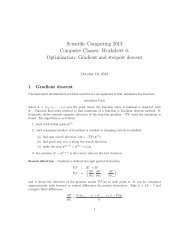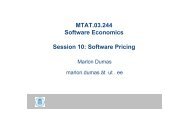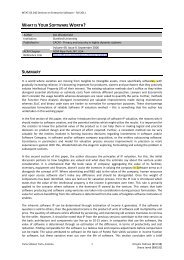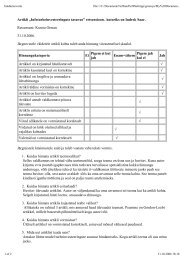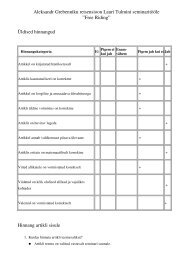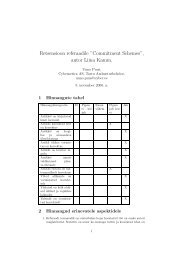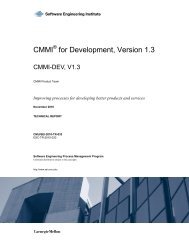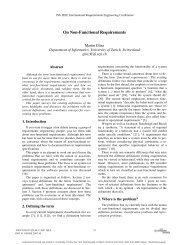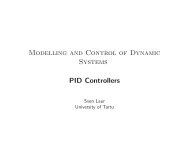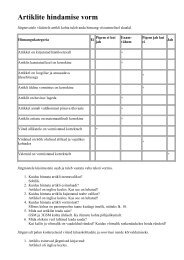A Model of Trust Evaluation for X.509 Certificate
A Model of Trust Evaluation for X.509 Certificate
A Model of Trust Evaluation for X.509 Certificate
You also want an ePaper? Increase the reach of your titles
YUMPU automatically turns print PDFs into web optimized ePapers that Google loves.
A <strong>Model</strong> <strong>of</strong> <strong>Trust</strong> <strong>Evaluation</strong> <strong>for</strong><br />
<strong>X.509</strong> <strong>Certificate</strong><br />
Abu Shohel Ahmed<br />
NordSecMob, University <strong>of</strong> Tartu
How to identify an anonymous persons in online<br />
or virtual world?<br />
Whom to <strong>Trust</strong><br />
2
Overview<br />
Digital <strong>Certificate</strong> & Public Key Infrastructure<br />
<strong>X.509</strong> <strong>Certificate</strong> Fields<br />
<strong>Trust</strong> in <strong>Certificate</strong> Authority policy<br />
Proposed <strong>Trust</strong> <strong>Evaluation</strong> Technique<br />
3
Digital <strong>Certificate</strong><br />
”A digital certificate is an electronic document<br />
which uses a digital signature to bind together a<br />
public key with an identity” — wiki<br />
Name<br />
Issuer<br />
Public Key<br />
Signature<br />
4
Public Key Infrastructure<br />
PKI allows us to<br />
know that a<br />
given key belongs<br />
to a given user.<br />
5
How to Get a <strong>Certificate</strong><br />
Create a public/private key pair<br />
Send a <strong>Certificate</strong> Signing Request.<br />
Provide your identity<br />
Get the signed certificate from CA<br />
Publish certificate<br />
6
How Validation Works<br />
<strong>Certificate</strong> validation chain<br />
Checking against OCSP or CRL<br />
7
<strong>X.509</strong> <strong>Certificate</strong><br />
<strong>Certificate</strong> <strong>for</strong>mat defined by IETF<br />
Some important fields:<br />
Key Usage<br />
<strong>Certificate</strong> Policy<br />
Name Constraint<br />
8
Extended Validated <strong>Certificate</strong><br />
A special type <strong>of</strong> <strong>X.509</strong> certificate that requires<br />
more extensive investigation <strong>of</strong> the requesting<br />
entity<br />
Based on certifcate<br />
policy mapping field.<br />
9
<strong>Certificate</strong> Authorities<br />
A set <strong>of</strong> trusted entities known as <strong>Certificate</strong><br />
Authorities (CAs) are established to sign<br />
certificates.<br />
<strong>X.509</strong> certificate delegates trust in certificate to<br />
CA.<br />
10
Where is <strong>Trust</strong> in <strong>Certificate</strong><br />
<strong>Certificate</strong> is granted based on two documents<br />
1. <strong>Certificate</strong> policy<br />
2. Certification practice statement<br />
But who will evaluate these policy and actual CA<br />
practice?<br />
How to automate trust evaluation process from<br />
this document?<br />
11
<strong>Trust</strong> evaluation in CA policy<br />
Some previous research:<br />
Criteriata <strong>for</strong> certificate trust requirements<br />
<strong>Certificate</strong> practice statement <strong>for</strong>malization or<br />
semi-<strong>for</strong>malization.<br />
Plat<strong>for</strong>m <strong>for</strong> Internet Content Selection rating<br />
service<br />
12
What Needs to be Introduced<br />
Introduction <strong>of</strong> a trust level in certificate<br />
fields. (currently defined in CP)<br />
Semi-<strong>for</strong>malization <strong>of</strong> CPS<br />
document<br />
13
Comparison<br />
Solution Advantage Disadvantage<br />
CPS semi <strong>for</strong>malization Processing is per<strong>for</strong>med<br />
using local knowledge<br />
which means applications<br />
can independently<br />
evaluate a certificate.<br />
<strong>Trust</strong> evaluation is based<br />
on weak assumptions<br />
(e.g., counting MUST).<br />
Requires online request to<br />
get CPS file.<br />
CPS <strong>for</strong>malization Provides more accurate CPS has no common<br />
in<strong>for</strong>mation about the standard. Requires an<br />
CPS file. online request <strong>for</strong> CPS<br />
file.<br />
Ratings<br />
service<br />
Flexible and easy to find<br />
rating <strong>for</strong> a certificate.<br />
Provides a clear direction<br />
about a certificate.<br />
<strong>Trust</strong> depends on the independent<br />
auditing<br />
authority. Requires an<br />
online request to get rating<br />
in<strong>for</strong>mation.<br />
14
Proposed <strong>Evaluation</strong> <strong>Model</strong><br />
Based on all the best known <strong>Trust</strong> solution <strong>for</strong><br />
certificate.<br />
Rating based system.<br />
Stepwise – Modular<br />
Incorporate online and <strong>of</strong>fline evaluation<br />
15
Discussion<br />
<strong>Model</strong> can be used <strong>for</strong> trust evaluation in most<br />
<strong>of</strong> the cases.<br />
<strong>Model</strong> is extendable with other rating feature.<br />
Mapped with VirtualLife indentification strategy.<br />
17
Questions<br />
18
References<br />
http://www.ietf.org/rfc/rfc2560.txt.<br />
http://www.ietf.org/rfc/rfc3280.txt.<br />
Borja Sotomayor. Certicates and certicate authorities.<br />
http://gdp.globus.org/gt3-tutorial/multipehtml/ch10s04.html.<br />
Gabriel A, Weaver, Scott Rea, Sean W, and Smith. A<br />
computational framework <strong>for</strong> certificate policy operations. In<br />
Dartmouth College Hanover, NH03755, USA<br />
19



